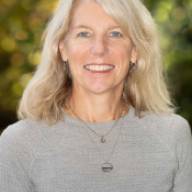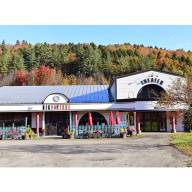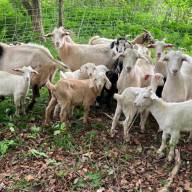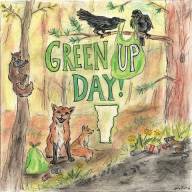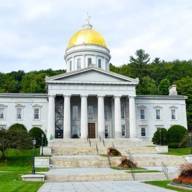While searching for what looked like (from an airplane) a beautiful plateau of open farm land on the east side of Route 12A in Roxbury, this reporter not only found the plateau, but also discovered the Vermont Forest Cemetery on Beaver Meadow Road.
Aided by the Vermont Gazetteer, my partner and I headed over the Roxbury Gap, crossed Route 12A and headed directly up Tracy Road which runs by Frazier’s Greenhouse and the Roxbury Village School. The road climbs steeply for a long time before Beaver Meadow Road appears on the right. We took the turn and in short order saw a sign for the Vermont Forest Cemetery which intrigued us so much we went back to check it out. What we found was a sign, an entry cottage, well built (and culverted) roads, trails, a map, and a business card for founder Michelle Hogle Acciavatti.
NATURAL PROCESS
What we could determine from our visit is that the cemetery hosts green burials, but we wanted to know more so we reached out to Acciavatti.
Acciavatti was born in California and raised outside of Boston. In 2013 she left a career in academic science and began working with people in the process of dying, first as a death worker and later as a death doula and then in a funeral home – ultimately attending mortuary school in 2017 and becoming a funeral director.
But between 2013 and 2017 she began exploring how the natural process of dying had become a medical event, rather than a natural event. She also got engaged with the process of lobbying Vermont to change its laws around natural cemeteries and natural burials.
DIED AT HOME
“One hundred fifty years ago, people died at home. They were washed and laid out at home without a funeral director. Death was rarely a medical event. Now, people are returning to this idea, that death is natural event and there’s a growing movement recognizing that we don’t need to outsource caring for the dead,” Acciavatti said.
Acciavatti and her husband moved to Montpelier in 2014 and worked in the commercial funeral industry until she and her husband began looking for land to create the state’s first forest cemetery. This was peak pandemic years when all land was being snapped up as soon as it went on the market. In 2021 they were able to purchase 65 acres in Roxbury, donating 56 acres to the Vermont Forest Cemetery.
Act 250 was surprisingly straightforward, but the permit required that the Roxbury Select Board hold hearings before okaying the project. Roxbury has no zoning which means there is no formal process for seeking a conditional use permit for such a cemetery.
LOCAL PROCESS
The local process took far longer than expected, but ultimately the cemetery opened in August 2023.
“Our first burial was in October 2023, and nine months in we’ve had 14 burials and sold 50 grave sites. We’re a nonprofit and people can purchase sites in advance, which helped us do things like roads, culverts and purchase an excavator,” she said. The first few graves were dug by hand.
Acciavatti is passionate about the work she’s doing and speaks swiftly and eloquently about why it matters.
“This is our way of sustaining the planet. We’re nutrients and we can give our bodies back to the earth, making them part of the cycle of life. But that body needs to be close enough to the soil so that its nutrients break down. The law in Vermont for natural cemeteries is 3.5 feet for burials,” she said.
SLEEPING BEAUTY
The United States, she pointed out is unusual in its embrace of embalming for the dead and entombing the dead in caskets which are placed in concrete vaults before being buried 6 feet under.
“It was a big marketing push – your loved one is like Sleeping Beauty. Nothing is returned to the earth,” she said.
Another factor that she and others engaged in natural burials are working through is the concept of ownership of graves and markers.
“The U.S. is also the only country that considers your grave yours forever more, like a participation trophy. In the rest of the world, graves are re-used,” she noted.
They’re working with the White River Natural Resources Conservation District on tests to determine how long it takes for bodies to decompose and when/if they can re-use the graves. Graves are located in sites that are 10 feet by 10 feet and families and the dead can decide what they want for markers if any.
A SIMPLER WAY
“This idea is appealing to people who want to go back to doing things a simpler way. It feels more meaningful to them than being buried in a cemetery. Our oldest person was 97 and the youngest was 22. We’ve had tragic deaths and normal deaths. What makes us unique is our mission includes conservation, learning and community. We’re more than a graveyard. We’re asking ‘how can this land sustain us in life and in death?’” Acciavatti said.
The Vermont Forest Cemetery is located just before Roxbury’s Orcutt Cemetery on the same road, a cemetery that dates back to the Revolutionary War (details in next week’s issue) and which is surrounded by the natural cemetery lands.
“Everybody buried there 150 years ago had a natural burial,” Acciavatti pointed out.
Those interested in learning more are invited to attend a July 20 tour of the Vermont Forest Cemetery which starts at 2 p.m. Details about the tour are be found at www.cemetery.com/tours and here is the website for the cemetery: https://www.cemetery.eco/. Inquiries via email can be sent to






